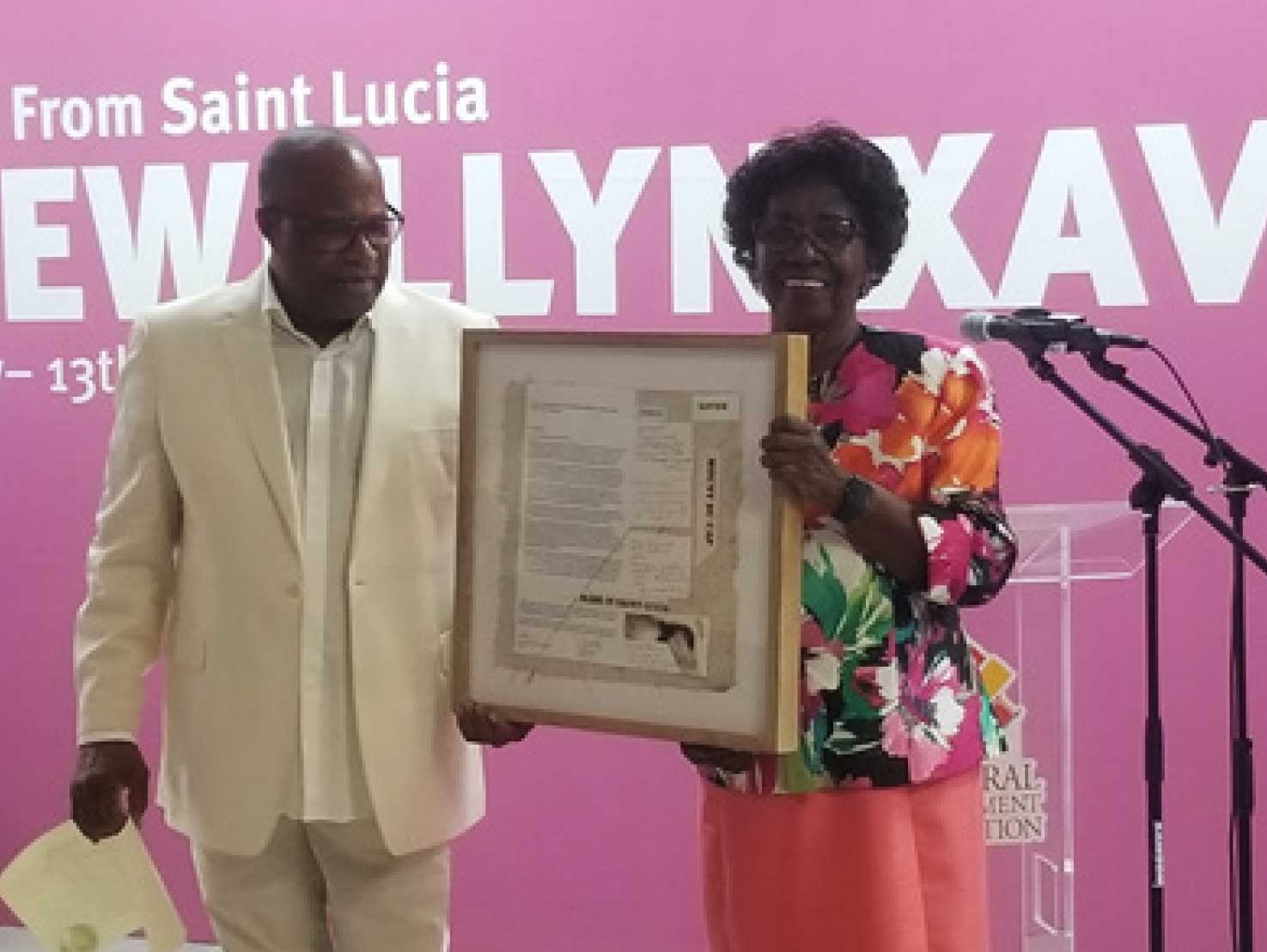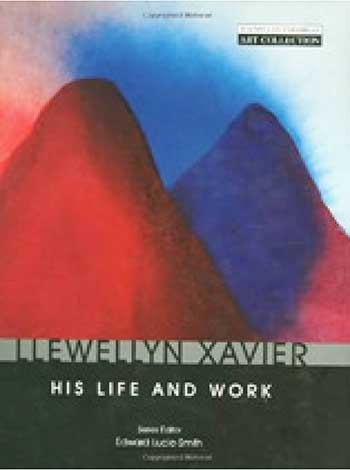
In his artistic statement for “Poems from Saint Lucia” the title exhibit of his three-part major, huge, massive exhibition at the Orange Grove Plaza from 4th May to 13th May, the 2024 National Cultural Icon, Llewellyn Xavier wrote, “Poems from Saint Lucia is a series of visual songs. An arrangement of colours and an attempt to understand the complexity of form. The focus shifts from colour to texture to form and blurs the boundaries between painting and sculpture.”
While this statement describes particularly the 200 pieces of the box-framed title series, it certainly also references the approximately 150 similarly boxed pieces of the collection called “Cold Fire” and the several hundred framed collages of the ecologically-themed “The Saint Lucia Chronicles.”
“Cold Fire”, according to the particular statement on that cycle, “is inspired by the Montagne Pélée eruption of May 8th 1902 in Martinique…glass was reduced to biomorphic blobs; heated to the maximum temperature.” The Cold Fire pieces are sculpted from heated glass, and mounted in boxes painted in an ascending, complementary spectrum of colours.
The “Poems from Saint Lucia” series are displayed also in boxed spectra of colours, 8 sets of 25 each, illustrating the artist’s attempt “to understand the complexity of form” where the boundaries are blurred between painting and sculpture. A signature feature of these is the recurring marble motif apparent in most of the pieces. An impasto technique is used where the paint is thick on the surface, so that brush and palette knife marks are apparent. Heavy- bodied paints and acrylic gels are at play also. A painter friend sees there “organic paintings in a very squared presentation.” The “organic quality” is also emphasized by the sculptural effect within the wooden boxed rectangular frames.
The painter’s ideas of creating “visual songs” provides intriguing speculations about the ideas of rhythm and a certain inherent, inscaped melody that inspired these paint-gathered pieces.
“The Saint Lucia Chronicles” continues in a literally huge, expansive way Xavier’s long interest in and concern with environmental and ecological issues. He roots this collage series firmly in his native Saint Lucia. They include island place names, common names of local families, names of well-known poets, artists and prime ministers, his various sketches, maps, images collected from numerous places and times in the manner of collage makers, birds and various exotic animals, quotations, even foreign languages, alongside his personal statements of concern about ecological dangers.
The Artist’s Statement for the Saint Lucia Chronicles says that they “are an attempt at memorializing the families of Saint Lucia in prose, poetry, photography, calligraphy…this is a contemporary work of art, and does not observe protocols, rules, regulations and conventions…made entirely from recycled materials from the artist’s studio, employing a multiplicity of techniques, materials, natural fibres and embellished with original artwork, antique prints, original manuscripts and maps from around the globe.”
So this art exhibition is not for those seeking traditional canvases of oil paints or water colours (though there are two large canvases of multi-colored abstracts,) or even the increasingly popular modern mobile installations and digital art. But in many ways, it is a unique showing of art forms and presentations that are probably not familiar to those visiting the large space of the Orange Grove Plaza.
My favourite section of this huge art show is the title collection “Poems from Saint Lucia” where I think the painter is at his most purely artistic, arranging colours obviously very carefully, discovering “the complexity of form”, blurring, as he writes, “the boundaries between painting and sculpture.” I had been intrigued from the first by the “marble” forms when I first saw them at the artist’s studio, and how they were sculpted, impasto-like, into thick layers of a variety of colours and shapes. I liked too how they were placed very carefully in a planned spectra of complementary colours.
Something similar is done with the “Cold Fire pieces”, but the “Poems from Saint Lucia” seem to have more organic movement and variety. The glass pieces, admittedly, as unique as they are, lend themselves to a greater stasis because of their material. The “Poems” pieces seem to have more obvious movement. My artist friend sees much of the “ethereal” and falling shapes that evoke waterfalls, which would point here also to Xavier’s ecological ideals.
Ok. I am not a visual, plastic artist as Mr. Xavier is. I am no art critic in the full sense of the term. I have great admiration for visual artists, and for a long time have explored art and sculpture through responding to them by writing ekphrastic poetry inspired by those works of art. I depend on artist friends and art critics to help me understand what artists are doing and how, with their materials. So I would certainly love to read reviews of this important exhibition by art critics who can better evaluate what they are viewing. There is no doubt Llewellyn Xavier is a major artist, already far better known and respected outside Saint Lucia. This performance, as huge and diverse as it is, presents a rare opportunity for his fellow citizens to see the artistic achievements of this Choiseul-born painter and environmental activist.
Xavier’s work is held in many permanent prestigious collections around the Western world. He has had Principal Exhibitions in many major cities. His famous series “Global Council for Restoration of the Earth’s Environment” opened in 1993, consisting of collages using recycled materials and carrying signatures of environmental leaders.
 The 2007 book “Llewellyn Xavier: His Life and Work” is an in-depth retrospective of St Lucia’s pre-eminent visual artist. From early representational oils, through work addressing racial and political themes in the 1960s to more ‘abstract’ series of watercolours, oils and collages drawing on Arawak and ancient myths, and celebrating the natural world. The work mirrors his love of the planet and no place more so than his native Pitons, icons of colour and light. The 360 colour plates in “Llewellyn Xavier: His Life and Work” are complemented by a commentary from the artist himself, an introduction by the eminent art critic and historian Edward Lucie-Smith and a foreword by Lowery Stokes Sims, expert in 20th Century Art and trustee of the Metropolitan Museum of Art.” (This note edited from Amazon Books).
The 2007 book “Llewellyn Xavier: His Life and Work” is an in-depth retrospective of St Lucia’s pre-eminent visual artist. From early representational oils, through work addressing racial and political themes in the 1960s to more ‘abstract’ series of watercolours, oils and collages drawing on Arawak and ancient myths, and celebrating the natural world. The work mirrors his love of the planet and no place more so than his native Pitons, icons of colour and light. The 360 colour plates in “Llewellyn Xavier: His Life and Work” are complemented by a commentary from the artist himself, an introduction by the eminent art critic and historian Edward Lucie-Smith and a foreword by Lowery Stokes Sims, expert in 20th Century Art and trustee of the Metropolitan Museum of Art.” (This note edited from Amazon Books).
Gratitude to the Cultural Development Foundation who selected Mr. Xavier as this year’s Cultural Icon and arranged to have his first major exhibition in Saint Lucia during the prestigious and popular Jazz and Arts season. The spaciousness of the Orange Grove Plaza floors provided an ideal venue. Xavier’s work, until now, has not been known enough in his home island. The accompanying Festival promotions hopefully brought many locals and visitors to see the work of this talented, obviously hard-working senior artist.
John Robert Lee is a Saint Lucian writer. His latest publications include Belmont Portfolio: poems (Peepal Tree,2023) and IKONS: New & Selected poems (Mahanaim Publishing; Msgr Patrick Anthony Folk Research Centre, 2023). He writes regularly for THE VOICE Newspaper in Saint Lucia.









![Simón Bolívar - Liberator of the Americas [Photo credit: Venezuelan Embassy]](https://thevoiceslu.com/wp-content/uploads/2025/12/Simon-Bolivar-feat-2-380x250.jpg)
